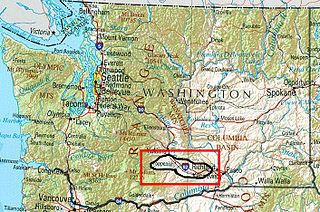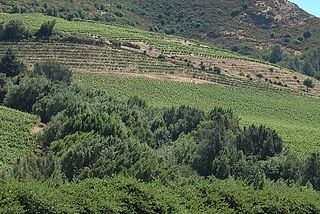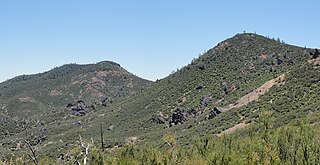
Washington wine is a wine produced from grape varieties grown in the U.S. state of Washington. Washington ranks second in the United States in the production of wine. By 2017, the state had over 55,000 acres (220 km2) of vineyards, a harvest of 229,000 short tons (208,000 t) of grapes, and exports going to over 40 countries around the world from the 940+ wineries located in the state. While there are some viticultural activities in the cooler, wetter western half of the state, the majority (99.9%) of wine grape production takes place in the shrub-steppe eastern half. The rain shadow of the Cascade Range leaves the Columbia River Basin with around 8 inches (200 mm) of annual rain fall, making irrigation and water rights of paramount interest to the Washington wine industry. Viticulture in the state is also influenced by long sunlight hours and consistent temperatures.

Willamette Valley is an American Viticultural Area (AVA) which lies in the Willamette Valley of Oregon. The AVA is the wine growing region which encompasses the drainage basin of the Willamette River. It stretches from the Columbia River in the north to just south of Eugene in the south, where the Willamette Valley ends; and from the Oregon Coast Range in the west to the Cascade Mountains in the east. At 5,360 square miles, it is the largest AVA in the state, and contains most of the state's wineries; approximately 908 as of 2021.

Columbia Valley is an American Viticultural Area (AVA) which lies within the Columbia River Plateau, through much of central and southern Washington state, with a section crossing the state boundary into northern Oregon south of the Columbia River. The viticultural area includes the drainage basin of the Columbia River and its tributaries through much of Washington. It was established by the Bureau of Alcohol, Tobacco and Firearms (ATF), Treasury on December 13, 1984 after evaluating the petition filed by Drs, Walter Clore and Wade Wolfe of Prosser, Washington on behalf of Washington’s oldest and largest winery, Chateau Ste. Michelle, and by William Blosser of the Sokol Blosser Winery, Dundee, Oregon. Allen Shoup, president of Chateau Ste. Michelle, understood the importance of obtaining appellation status to grow the reputation of the Northwest viticulture industry.

Yakima Valley is the first American Viticultural Area (AVA) established within Washington state, gaining the recognition on May 4, 1983. Within the vast Columbia Valley AVA, Yakima Valley appellation cultivates more than 53,000 acres (21,448 ha) giving the region the largest concentration of wineries and vineyards in the state. The most widely planted varietals in the area are Chardonnay, Riesling, Merlot, Cabernet Sauvignon, Pinot gris, and Syrah. Nearly 40% of Washington's annual wine production is made from Yakima Valley grapes. In addition to grapes, the Yakima Valley is also home to several fruit orchards growing apples, cherries, nectarines, peaches, pears and plums. Around the town of Zillah, there is the Zillah Fruit Loop driving tour through the area's orchards and vineyards. The area is also home to nearly 80% of the US hop production.

Walla Walla Valley is an American Viticultural Area (AVA) located within Washington state and extending partly into the northeastern corner of Oregon. The wine region is entirely included within the larger Columbia Valley AVA. In addition to grapes, the area produces sweet onions, wheat and strawberries After the Yakima Valley AVA, the Walla Walla AVA has the second highest concentration of vineyards and wineries in Washington State. Walla Walla hosts about 140 wineries. The area was recognized on March 7, 1984 by the Bureau of Alcohol, Tobacco and Firearms (ATF), Treasury after reviewing the petition submitted by Mr. Richard L Small, President of the Walla Walla Valley Winegrowers Association, for the establishment of a viticultural area in southeast Washington and northeast Oregon, east of Lake Wallula, to be known as "Walls Walls Valley." At the time, Walla Walla Valley viticultural area was approximately 178,560 acres (279 sq mi) with two bonded wineries and about 60 acres (24 ha) from several vineyards.

Wahluke Slope is an American Viticultural Area (AVA) located within Grant County, Washington. It was established on January 6, 2006, by the Alcohol and Tobacco Tax and Trade Bureau (TTB), Treasury after reviewing the petition submitted by the Wahluke Slope Wine Grape Growers Association (WSWGGA), represented by Alan J. Busacca, Ph.D., proposing the establishment of the viticultural area named "Wahluke Slope."

Snake River Valley is Idaho's first American Viticultural Area (AVA) that encompasses an area in southwestern Idaho and two counties in eastern Oregon. The area was established on April 9, 2007 by the Alcohol and Tobacco Tax and Trade Bureau (TTB), Treasury after reviewing the petition submitted by Idahoan vintners of the Snake River Valley, the Idaho Grape Growers and Wine Producers Commission, and the Idaho Department of Commerce and Labor, collectively acting as “petitioner” to establish the 8,263 square miles viticultural area named "Snake River Valley." For wines to bear the "Snake River Valley" label, at least 85% of the grapes used for production must be grown in the designated area, which includes the southwestern Idaho counties of Ada, Adams, Boise, Canyon, Elmore, Gem, Gooding, Jerome, Owyhee, Payette, Twin Falls, and Washington, and the Eastern Oregon counties of Malheur and Baker. The appellation, when established, was resident to 15 wineries and 46 vineyards with 1,800 acres (728 ha) under vine.
Arroyo Grande Valley is an American Viticultural Area (AVA) located in San Luis Obispo County, California approximately 12 miles (19 km) southeast of the county seat San Luis Obispo. Arroyo Grande Valley was recognized on February 5, 1990 by the Bureau of Alcohol, Tobacco, Firearms and Explosives (ATF) as the state's 60th AVA based on the petition filed in 1987 by Don Talley of Talley Vineyards and William S. Greenough of Saucelito Canyon Vineyard for the establishment of the "Arroyo Grande Valley" viticultural area in San Luis Obispo County. The 16 miles (26 km) long, approximately 67 square miles valley appellation benefits from its east-northeast orientation allowing the breeze from the Pacific Ocean to moderate the climate of the area. The valley is divided by a fog line produced by the cool maritime layer where Zinfandel, Petite Sirah and Rhône varietals are grown on the higher elevations near Lopez Lake and the cooler mid-valley vineyards being home to Chardonnay and Pinot noir. On April 8, 2022, the Alcohol and Tobacco Tax and Trade Bureau (TTB) approved the designation of the expansive San Luis Obispo (SLO) Coast AVA overlapping the boundaries of Edna Valley and Arroyo Grande Valley viticultural areas because they share common features. However, these two previously established areas still have unique characteristics to retain their viticultural area distinctions within SLO Coast. Edna Valley lies immediately to the northwest, the Los Padres National Forest straddles the north leg boundary, the Santa Maria Valley AVA lies to the southeast of Arroyo Grande Valley, and the Pacific Ocean communities of Oceano, Grover City and Arroyo Grande abut its southwestern border.

Lake Chelan is an American Viticultural Area (AVA) in Washington state. The appellation lies about 112 miles (180 km) northeast of Seattle located in north-central Washington's Lake Chelan Valley and is a sub-appellation of the vast Columbia Valley AVA. It lies east of the Puget Sound viticultural area and north or west of the other Washington State viticultural areas. It borders the Columbia Valley viticultural area on is eastern side and does not include any portion of other Washington viticultural areas except the Columbia Valley AVA.

Ancient Lakes of Columbia Valley, also locally called Ancient Lakes, is an American Viticultural Area (AVA) which lies on the western edge of the Columbia Basin near the town of Quincy in Douglas, Grant, and Kittitas Counties in the state of Washington. The appellation lies entirely within the vast Columbia Valley viticultural area and was established on November 19, 2012, as the state's 13th AVA, by the Alcohol and Tobacco Tax and Trade Bureau (TTB), Treasury. The petition was received by TTB from Joan R. Davenport, a professor of soil sciences at Washington State University, and Cameron Fries of White Heron Cellars, on behalf of the vintners and grape growers in the Ancient Lakes region in central Washington, proposing the establishment of the "Ancient Lakes of Columbia Valley" viticultural area.

The Upper Hudson AVA is an American Viticultural Area located to the north and west of Albany, New York. It is approximately 1650 square miles with nearly 65 acres of vines planted and 19 vineyards. It includes parts or all of seven counties in upstate New York, specifically Albany, Montgomery, Rensselaer, Saratoga, Schenectady, Schoharie and Washington.

The Van Duzer Corridor AVA, a sub-appellation of the Willamette Valley AVA located within Polk County, Oregon, in the United States, is an American Viticultural Area approved by the Alcohol and Tobacco Tax and Trade Bureau on December 13, 2018 and effective January 14, 2019.
Los Olivos District AVA is an American Viticultural Area located in Santa Barbara County, California established on January 20, 2016, by the Alcohol and Tobacco Tax and Trade Bureau (TTB). It straddles the Santa Ynez Valley, formed by the Santa Ynez River, between the Purisima Hills above Solvang. The area encompasses the townships of Los Olivos, Ballard, Santa Ynez and Solvang. State Route 154, known locally as the San Marcos Pass Road or Chumash Highway, bisects the region accessing many of the wineries and vineyards as it traverses toward its destination in Santa Barbara.

Moon Mountain District Sonoma County is an American Viticultural Area (AVA) within Sonoma Valley and North Coast viticultural areas, just north of the city of Sonoma. This mountainous region on the very eastern edge of Sonoma County has a historic reputation for producing rich, intensely-flavored wines from Cabernet Sauvignon and Syrah varietals since the 1880s. The District was established on November 1, 2013, by the Alcohol and Tobacco Tax and Trade Bureau (TTB). Its designation covers 17,663 acres (28 sq mi) of land stretching north-south along the western slopes of the Mayacamas mountains between Sugarloaf Ridge State Park and Los Carneros viticultural area with the Napa Valley’s Mount Veeder viticultural area outlining the eastern slopes. Its name is derived from Moon Mountain Road, which traverses through the area and itself a reference to Sonoma, which means 'valley of the moon' in the local Native American dialect. A clear view to San Francisco 50 miles (80 km) south is not uncommon from Moon Mountain District vineyards.
Alisos Canyon is an American Viticultural Area (AVA), located in Santa Barbara County, California due east outside the small town of Los Alamos on U.S 101 and about 20 miles (32 km) south of Santa Maria, was established on August 25, 2020, by the Alcohol and Tobacco Tax and Trade Bureau (TTB). Alisos Canyon stretches west to east over 9 square miles with one bonded winery and nine commercially-producing vineyards cultivates on approximately 238 acres (96 ha). Alisos Canyon Road bisects the region accessing many of its vineyards. The USDA plant hardiness zone for the AVA is 7b.

San Luis Obispo Coast and SLO Coast identify the sixteenth American Viticultural Area (AVA) within San Luis Obispo County, California. It was established by the Alcohol and Tobacco Tax and Trade Bureau (TTB), Treasury on April 8, 2022, becoming the state's 143rd official AVA. The area encompasses over 480,585 acres (750.914 sq mi) nestled between the Santa Lucia mountains and the Pacific coastline stretching about 70 miles (110 km) from Ragged Point southbound on the Pacific Coast Highway (PCH) and Highway 101 to the outskirts of Santa Maria at the intersection of State Highway 166 and Highway 101. It includes the coastal communities of San Simeon, Cambria, Cayucos, Morro Bay, Avila Beach, Pismo Beach, Arroyo Grande and Nipomo while encompassing the county seat of San Luis Obispo. The TTB approved the petition's two names, "San Luis Obispo Coast" and "SLO Coast", to identify the viticultural area's description and wine labeling. The term "SLO" is a historical and commonly used reference for the county and city initials as well as a description of the region's relaxed culture. The new AVA overlaps the previously established Edna Valley and Arroyo Grande Valley viticultural areas. There are over 50 wineries and an estimated 78 commercial vineyards cultivating approximately 3,942 acres (1,595 ha) with a majority of the vineyards located within 6 miles (9.7 km) of the Pacific Ocean defining an area whose grapes and wines represent it. Cool weather varietals like Pinot Noir and Chardonnay are commonly grown while lesser varietals Sauvignon Blanc, Gewürztraminer and Gruner Veltliner also thrive.

Gabilan Mountains is an American Viticultural Area (AVA) located in the mountainous region on the border in Monterey and San Benito Counties in California. It is the tenth and newest AVA established in Monterey County by the Alcohol and Tobacco Tax and Trade Bureau (TTB) on September 14, 2022, becoming the state's 147th official AVA after the TTB reviewed the petition from Parker Allen of Coastview Vineyards, proposing to establish the "Gabilan Mountains" viticultural area. Gabilan Mountains encompasses about 98,000 acres (153 sq mi) including the established Mt. Harlan and Chalone AVAs, and resident to 4 wineries and 6 commercial vineyards cultivating approximately 436 acres (176 ha). The average elevation within the region is 2,370 feet (722 m) placing it above the heavy fog and marine layer. As a result, Gabilan Mountains AVA has a cool air climate without the humidity from the fog and low-lying clouds.

Goose Gap is the 19th American Viticultural Area (AVA) in Washington, United States. It encompasses the local region surrounding Goose Mountain in Benton County between Kiona to the west, and Richland along the Columbia River to the east. The viticultural area was formally established on August 2, 2021, by the Alcohol and Tobacco Tax and Trade Bureau (TTB), Treasury after reviewing the petition submitted by geologist/vintner, Alan Busacca, on behalf of the Goose Gap Wine Grower's Association, proposing the viticultural area "Goose Gap". The area is a sub-appellation entirely within the Yakima Valley and the expansive Columbia Valley AVAs sandwiched on a northwest–southeast axis between neighboring viticultural areas Red Mountain and the minute Candy Mountain.

Candy Mountain is an American Viticultural Area (AVA) in Washington that encompasses the slopes surrounding Candy Mountain in Benton County located southwest of Richland along the Columbia River. The viticultural area is the state's 16th AVA formally established on September 24, 2020, by the Alcohol and Tobacco Tax and Trade Bureau (TTB), Treasury after reviewing the petition submitted by Dr. Kevin R. Pogue, professor of geology at Whitman College, on behalf of the following industry members with wine businesses within the Candy Mountain appellation: Ramer Holtan, who is developing a commercial wine grape vineyard on Candy Mountain; Premiere Columbia Partners LLC, owners of Candy Mountain Vineyard; and Paul and Vickie Kitzke, owners of Kitzke Cellars. For wines to bear the “Candy Mountain AVA” label, at least 85% of the grapes used for production must be grown in the designated area, Candy Mountain is a sub-appellation entirely within the Yakima Valley and the expansive Columbia Valley AVAs adjacent to the eastern boundary of Goose Gap AVA and few miles southeast of Red Mountain AVA. Within the 815 acres (330 ha) minute AVA, there are currently two producing commercial vineyards, Candy Mountain Vineyard and Kitzke Cellars, which cultivate approximately 54 acres (22 ha) with future expansions for 200 acres (81 ha)

The Burn of Columbia Valley is an American Viticultural Area (AVA) located within Klickitat County in south-central Washington on the north banks of the Columbia River along the Oregon state border. The Burn of Columbia Valley was established by the Alcohol and Tobacco Tax and Trade Bureau (TTB), Treasury on July 17, 2021, after reviewing a petition received from Kevin Corliss, Vice President of Vineyards for Ste. Michelle Wine Estates, Joan R. Davenport, Professor of Soil Sciences at Washington State University, and John Derrick, Vice President of Operations for Mercer Ranches, Inc., proposing “The Burn of Columbia Valley” viticultural area. The appellation, known colloquially as “The Burn,” encompasses about 16,870 acres (26 sq mi) where 3 commercial vineyards cultivate approximately 1,261 acres (510 ha) as many Washington wineries source grapes from here. The state's 18th AVA lies entirely within the vast Columbia Valley appellation and stands alone between the Columbia Gorge and the Horse Heaven Hills viticultural areas. The distinguishing features of The Burn of Columbia Valley are its soils, climate, and topography.

















